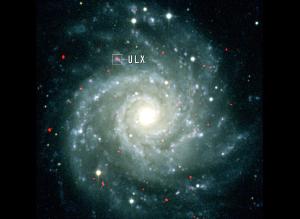Post
The Inbetweeners
23 May 2013
Yesterday I mentioned the possibility that a mid-sized black hole might explain why the Trapezium cluster is gravitationally bound. If such an black hole were discovered it would be a really big deal.
We know that black holes exist, but they seem to come in only two sizes: stellar and supermassive. Stellar black holes are formed when large stars reach the end of their life and their core collapses. They typically mass less than 20 solar masses. Supermassive black holes lie at the heart of galaxies. They form during a galaxy’s youth and can be a million solar masses or more.
Between these two extremes should be intermediate mass black holes (IMBHs). These would be hundreds or thousands of solar masses. Too large to have formed from a single star, but not a supermassive heart of a galaxy. An intermediate black hole could form from a stellar mass black hole by accreting gas, dust or nearby stars. They might form by stellar collisions within a dense star cluster, or perhaps they could form during the early universe when gas and dust were more dense.
We don’t know of any reason why intermediate black holes couldn’t form, but so far we haven’t observed any. We’ve discovered lots of black holes, but so far they only come in small or large. We do however have some indirect evidence that intermediate mass black holes exist.
 X-ray: NASA/CXC/U. of Michigan/J.Liu et al.; Optical: NOAO/AURA/NSF/T.Boroson
X-ray: NASA/CXC/U. of Michigan/J.Liu et al.; Optical: NOAO/AURA/NSF/T.BorosonOne example can be seen in the image here. It is a composite image of x-ray (red) and optical (blue/white) observations. The ULX box indicates an Ultra Luminous X-ray source. This x-ray source varies in brightness about every two hours. This is interesting because the rate at which an x-ray source varies is determined by the mass of its source. The x-rays come from the accretion disk of the black hole, since different portions of the accretion disk can’t interact faster than light can travel between those regions, larger accretion disks vary more slowly than smaller accretion disks.
With a period of two hours, that would put the the black hole at about 10,000 solar masses. That would make it an inbetweener. This is, of course, assuming it is actually a black hole. The most likely explanation is that this is a mid-size black hole, but it will take more detailed observations of the dynamics to rule out alternatives such as a very dense star cluster.
So if the Trapezium cluster really does have a mid-sized black hole, that would be pretty cool.